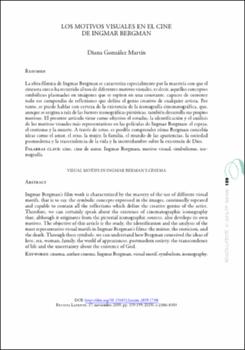Los motivos visuales en el cine de Ingmar Bergman
Author
González Martín, DianaDate
2019Abstract
La obra fílmica de Ingmar Bergman se caracteriza especialmente por la maestría con que el
cineasta sueco ha recurrido al uso de diferentes motivos visuales, es decir, aquellos conceptos
simbólicos plasmados en imágenes que se repiten en una constante, capaces de contener
todo ese compendio de reflexiones que define el genio creativo de cualquier artista. Por
tanto, se puede hablar con certeza de la existencia de la iconografía cinematográfica, que,
aunque se origina a raíz de las fuentes iconográficas pictóricas, también desarrolla sus propios
motivos. El presente artículo tiene como objetivo el estudio, la identificación y el análisis
de los motivos visuales más representativos en las películas de Ingmar Bergman: el espejo,
el erotismo y la muerte. A través de estos, es posible comprender cómo Bergman concebía
ideas como el amor, el sexo, la mujer, la familia, el mundo de las apariencias, la sociedad
posmoderna y la trascendencia de la vida y la incertidumbre sobre la existencia de Dios. Ingmar Bergman’s film work is characterized by the mastery of the use of different visual
motifs, that is to say, the symbolic concepts expressed in the images, continually repeated
and capable to contain all the reflections which define the creative genius of the artist.
Therefore, we can certainly speak about the existence of cinematographic iconography
that, although it originates from the pictorial iconographic sources, also develops its own
motives. The objective of this article is the study, the identification and the analysis of the
most representative visual motifs in Ingmar Bergman’s films: the mirror, the eroticism, and
the death. Through these symbols, we can understand how Bergman conceived the ideas of
love, sex, woman, family, the world of appearances, postmodern society, the transcendence
of life and the uncertainty about the existence of God.





